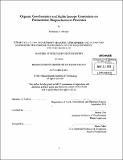Organic geochemistry and stable isotope constraints on Precambrian biogeochemical processes
Author(s)
Thomas, Katherine S., S.M. Massachusetts Institute of Technology
DownloadFull printable version (9.426Mb)
Other Contributors
Massachusetts Institute of Technology. Dept. of Earth, Atmospheric, and Planetary Sciences.
Advisor
Shuhei Ono.
Terms of use
Metadata
Show full item recordAbstract
Details of the biogeochemical cycles and the dominant mechanisms present in Precambrian remain heavily debated topics. The events of the Late Proterozoic onset to glaciations and what types of early life existed in the Archean are two of the many provoking topics within the Precambrian. We set out to improve the understanding of these geologic intervals by examining stable isotopic signatures and molecular fossils (biomarkers) in Late Proterozoic and Mesoarchean ages sedimentary rocks in Northwestern Territories, Canada and Pilbara, Western Australia, respectively. This thesis presents sulfur, carbon, oxygen and nitrogen stable isotopic data along with distribution of steranes and hopanes biomarkers. Geochemical data is analyzed in the context of elucidating the key biological and environmental factors involved in the Mesoarchean marine biosphere and the Late Proterozoic onset of glaciations. Stable isotopic analysis of the Gorge Creek Group in Pilbara, Western Australia reveals organisms capable of microbial sulfur disproportionation were likely the dominant biological players in Mesoarchean deep-ocean sulfur cycling. Biomarker and isotopic proxies of the Coppercap Formation reveal diverse biological activity directly prior to the Sturtian Glaciation with communities of green and purple sulfur bacteria as well as methanotrophs and cyanobacteria. Possible environmental implications of these communities co-existing are explained in context of changes in ocean chemistry and the diversification of eukaryotic life.
Description
Thesis (S.M.)--Massachusetts Institute of Technology, Dept. of Earth, Atmospheric, and Planetary Sciences, 2011. Cataloged from PDF version of thesis. Includes bibliographical references (p. 91-101).
Date issued
2011Department
Massachusetts Institute of Technology. Department of Earth, Atmospheric, and Planetary SciencesPublisher
Massachusetts Institute of Technology
Keywords
Earth, Atmospheric, and Planetary Sciences.